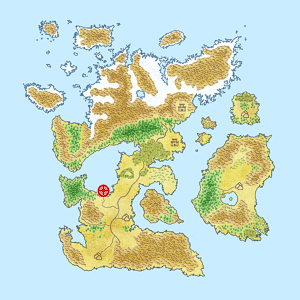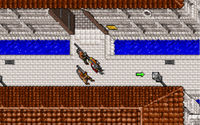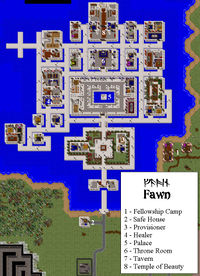Fawn
This article is about a city in Ultima VII Part Two. For the city in previous Ultima titles, see Old Fawn.
| Fawn | |
|---|---|
 Location of Fawn | |
| Located in: | Serpent Isle |
| Type: | town |
 The Streets of Fawn | |
Fawn is a city on Serpent Isle that appears in Ultima VII Part Two.
Description[edit]
Fawn was built atop the waters of a bay on the western coast of Serpent Isle's mainland, situated to the north of the Knight's Test and the forest surrounding it. A city of sailors and fishermen, it served as its world's primary supplier of fish in its heyday, and the bulk of travel and trade between the Isle of Beyond and the rest of New Sosaria was carried out by the Fawnish fleet. Unlike other cities, Fawn is set for optical beauty, with all buildings being build from white marble and surrounded with other beautifications.
At the time of the Avatar's adventures on Serpent Isle, an aura of doom seemed to hang over Fawn and its people. In the days leading up to the Imbalance, the entirety of Fawn's fleet was destroyed by magical storms, leaving an economically unstable populace whose thoughts were heavy with grief over those lost at sea and weighed down with fear regarding the increasingly bold goblin hordes. As it became clear to many that the powers of the government had been usurped by Kylista, priestess of the state Cult of Beauty, and the royal adviser Voldin, unrest became rife among the city's youth, and the arrival of Fellowship missionaries from distant Britannia proved to be a catalyst that helped to shape an underground cause opposing the current regime.[1]
History[edit]
The denizens of Fawn are descendants of the people of an ancient Sosarian city of the same name, which was said to have been founded by and named for the brilliantly beautiful Lady Fawn. Along with dissidents from the twin settlements of Montor and the city of Moon, a number of the original Fawnese joined the magician Erstam in emigrating from what was then becoming the early kingdom of Britannia. They opposed Lord British's system of the Eight Virtues, believing that the abstract concept of Beauty should be acknowledged as a ninth virtue and revered as a guiding spiritual principle.[2] The rejection of Beauty as a potential virtue by the government had created deep resentment in its followers.
These settlers traversed the mystical Serpent Pillars on a ship known as the Osprey,[3] and eventually came to land on the shores of what had once been the Lands of Danger and Despair in the days before the Stranger had shattered Mondain's gem.[4] The Fawnese built a city here in the vicinity of what would have once been the ancient settlement of Dextron, and there they established their sacred Oracle of Beauty and made the worship of Beauty into a state religion.[5] Under this religion, it was believed only women were capable of True Beauty, and so the rulers of Fawn were always female, with the highest position a man could achieve being a Great Captain, a member of the ruler's council of advisors.[6] However, the women of Fawn were also coddled and discouraged from doing anything that might mar their beauty.[7][8]
The Imbalance storms however ruined the economy of the city, as the entire fleet was destroyed by the lightning strikes, also costing the city a good chunk of its population in the process. The inevitable ruin caused Fawn to slide into a state of gloom and depression. The last days of Fawn were eventful. The Avatar had discovered a conspiracy of high-up that held Lady Yelinda, the nominal ruler, powerless and ignorant, toppling the conspirators in the end. But the new rule was only short, when Mad Iolo came to Fawn. He killed next to all inhabitants while letting loose vermin and plague. This was the end of Fawn.
Lore[edit]
| “ | This unusual village is named after its original in Sosaria, which in turn is named for its founding queen. Lady Fawn, renowned for her lovely appearance, held beauty as the one true trait of value. In her honor, the town quickly adopted the same belief. Though Lady Fawn has since died, her rather superficial values continue on. A port town, Fawn’s main sources of income are the various sea-based occupations, including ship building and fishing. The currency accepted in Fawn is called the Filari. |
|---|
| “ | The third group of settlers came from Fawn. When they arrived on this island they knew they had truly found their new home, for its beauty rivaled that of the homeland they had left behind. They settled in a picturesque area on the west side of the island and built the lovely Fawn, in honor of their former home. ... The first thing that struck me about Fawn was the beauty of its white stone houses. With their red tile roofs and, neat gardens set against the backdrop of a sparkling blue sea, they make the town both picturesque and charming. I entered the city through the gatehouse and found myself in a lovely plaza. – from Balancing the Scales (Ultima VII Part Two)
|
|---|
Inhabitants[edit]
- Alyssand: weaver
- Delin: provisioner
- Delphynia: horticulturalist
- Garth: Great Captain
- Jendon: tavern keeper
- Jorvin: captain of the guard
- Joth: Great Captain
- Kylista: Priestess of Beauty
- Lady Yelinda: Ruler of Fawn
- Olon: sailor
- Voldin: Great Captain
- Zulith: Chancellor of Fawn
Deceased:
- Seth: healer
Temporary Inhabitants[edit]
Services[edit]
- Broken Oar: tavern/inn
- Provisioner
- Delphynia's Apothecary
Places of Interest[edit]
Trivia[edit]
- The original plans for Fawn were quite different from the final game. In these, instead of killing everyone, Mad Iolo installed himself as the ruler of Fawn and ruled with twisted metaphors against certain people. Additionally, he let loose plague and vermin, enjoying watching the vain citizens getting uglier with each hour under such horrible conditions. Of all these things, only the skinning of Lady Yelinda (beauty is only skin-deep) survived into the final game. The vermin is seen in the streets, but has no context in the final game.
- The way the city looks is a very big hint to veterans of the series of the deeper troubles of Fawn. Fawn essentially looks exactly as Magincia was described in The History of Britannia, a decadent city of marble palaces. From there it is a short path to realizing that the worship of Beauty leads to an huge amount of narcissism , which is just another facet of Pride. Fittingly, like Magincia, Fawn takes a very bad end.
References[edit]
- ↑ Alyssand. Paul Carr’s Ultima transcripts. Ultima VII Part Two. "evil schemes, false traditions, fleet, Goblins, the Cause".
- ↑ Andrew of Monitor. Courageous Deeds (Ultima VII Part Two – in-game).
- ↑ Hobbs, Sheri Graner. Balancing the Scales (Ultima VII Part Two). Origin Systems, Inc.: 1993.
- ↑ Morris, Andrew P.. Beyond the Serpent Pillars (Ultima VII Part Two). Origin Systems, Inc.: 1993.
- ↑ Kylista. Paul Carr’s Ultima transcripts. Ultima VII Part Two. "Oracle".
- ↑ Alyssand. Paul Carr’s Ultima transcripts. Ultima VII Part Two. "Great Captains".
- ↑ Fawn Guard. Paul Carr’s Ultima transcripts. Ultima VII Part Two. "Why are thou following me?, Law, endanger".
- ↑ Alyssand. Paul Carr’s Ultima transcripts. Ultima VII Part Two. "Lady Yelinda".
| Geography |
|---|
| ExpandBritannia |
|---|
| ExpandPagan |
|---|

